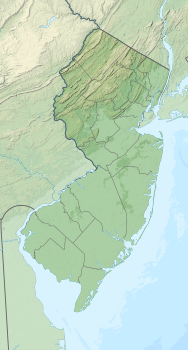
A | B | C | D | E | F | G | H | CH | I | J | K | L | M | N | O | P | Q | R | S | T | U | V | W | X | Y | Z | 0 | 1 | 2 | 3 | 4 | 5 | 6 | 7 | 8 | 9
Elizabeth, New Jersey | |
|---|---|
 Elizabeth skyline in October 2015 | |
| Motto: Loyal Devoir[1] | |
 Location of Elizabeth in Union County highlighted in yellow (center). Inset map: Location of Union County in New Jersey highlighted in black (upper right). | |
 Census Bureau map of Elizabeth, New Jersey | |
Location of Elizabeth in Union County Location in New Jersey | |
| Coordinates: 40°39′47″N 74°12′50″W / 40.663°N 74.214°W[2][3] | |
| Country | |
| State | |
| County | Union |
| Founded | 1664 |
| Incorporated | March 13, 1855 |
| Named for | Elizabeth, wife of Sir George Carteret |
| Government | |
| • Type | Faulkner Act (mayor–council) |
| • Body | City Council |
| • Mayor | J. Christian "Chris" Bollwage (D, term ends December 31, 2024)[4][5] |
| • Administrator | Bridget S. Anderson[6] |
| • Municipal clerk | Yolanda Roberts[7] |
| Area | |
| • Total | 13.64 sq mi (35.32 km2) |
| • Land | 12.32 sq mi (31.91 km2) |
| • Water | 1.32 sq mi (3.42 km2) 9.78% |
| • Rank | 180th of 565 in state 1st of 21 in county[2] |
| Elevation | 16 ft (5 m) |
| Population | |
| • Total | 137,298 |
| • Estimate | 135,829 |
| • Rank | 206th in country (as of 2023)[14] 4th of 565 in state 1st of 21 in county[15] |
| • Density | 11,145.22/sq mi (4,303.27/km2) |
| • Rank | 32nd of 565 in state 2nd of 21 in county[15] |
| Time zone | UTC−05:00 (Eastern (EST)) |
| • Summer (DST) | UTC−04:00 (Eastern (EDT)) |
| ZIP Codes | |
| Area code | 908[18] |
| FIPS code | 3403921000[2][19][20] |
| GNIS feature ID | 0885205[2][21] |
| Website | www |

Elizabeth is a city in and the county seat of Union County, in the U.S. state of New Jersey.[22] As of the 2020 United States census, the city retained its ranking as the state's fourth-most-populous city behind neighboring Newark, Jersey City, and Paterson,[23][24] with a population of 137,298,[11][12] an increase of 12,329 (+9.9%) from the 2010 census count of 124,969,[25][26] which in turn reflected an increase of 4,401 (3.7%) from the 120,568 counted in the 2000 census.[27]
The Population Estimates Program calculated a population of 135,829 for 2023, making it the 206th-most populous municipality in the nation,[14] making it the fifth-most populous municipality of any type in the state, falling behind Lakewood Township, where the population that year was estimated to be 139,866.[14]
History


Elizabeth, originally called "Elizabethtown" and part of the Elizabethtown Tract, was founded in 1664 by English settlers. The town was not named for Queen Elizabeth I as many people may assume, but rather for Elizabeth, wife of Sir George Carteret,[28] one of the two original Proprietors of the colony of New Jersey.[29][30][31] She was the daughter of Philippe de Carteret II, 3rd Seigneur de Sark and Anne Dowse. The town served as the first capital of New Jersey.[32]
During the American Revolutionary War, Elizabethtown was continually attacked by British forces based on Manhattan and Staten Island, culminating in the Battle of Springfield which decisively defeated British attempts to gain New Jersey. After independence, it was from Elizabethtown that George Washington embarked by boat to Manhattan for his 1789 inauguration.[33] There are numerous memorials and monuments of the American Revolution in Elizabeth.[34]
On March 13, 1855, the City of Elizabeth was created by an act of the New Jersey Legislature, combining and replacing both Elizabeth Borough (which dated back to 1740) and Elizabeth Township (which had been formed in 1693), subject to the results of a referendum held on March 27, 1855. On March 19, 1857, the city became part of the newly created Union County. Portions of the city were taken to form Linden Township on March 4, 1861.[35]
The first major industry, the Singer Sewing Machine Company came to Elizabeth and employed as many as 2,000 people. In 1895, it saw one of the first car companies, when Electric Carriage and Wagon Company was founded to manufacture the Electrobat, joined soon by another electric car builder, Andrew L. Riker. The Electric Boat Company got its start building submarines for the United States Navy in Elizabeth, beginning with the launch of USS Holland (SS-1) in 1897. These pioneering naval craft (known as A-Class) were developed at Lewis Nixon's Crescent Shipyard in Elizabeth between the years 1896–1903.[36] Elizabeth grew in parallel to its sister city of Newark for many years, but has been more successful in retaining a middle-class presence and was mostly spared riots in the 1960s.[37]
On September 18, 2016, a backpack holding five bombs was discovered outside NJ Transit's Elizabeth train station. One bomb detonated accidentally when a bomb squad robot failed to disarm the contents of the backpack; no one was hurt. Police were initially unsure if this event was related to bombs in Seaside Park, New Jersey, and Manhattan that had exploded the previous day.[38]
The following day, on September 19, police arrested Ahmad Khan Rahami, a 28-year-old Afghan-born naturalized U.S. citizen, for questioning in connection with all three incidents; the FBI considered Rahami, whose last known address was within 0.5 miles (0.8 km) of the train station, to be armed and dangerous.[39][40]
Geography
According to the U.S. Census Bureau, the city had a total area of 13.66 square miles (35.37 km2), including 12.32 square miles (31.91 km2) of land and 1.34 square miles (3.46 km2) of water (9.78%).[2][3]
Elizabeth is bordered to the southwest by Linden, to the west by Roselle and Roselle Park, to the northwest by Union and Hillside, to the north by Newark (in Essex County). To the east the city is across Newark Bay from Bayonne in Hudson County and the Arthur Kill from Staten Island, New York.[41][42][43]
The borders of Elizabeth, Bayonne, and Staten Island meet at one point on Shooters Island, of which 7.5 acres (3.0 ha) of the island is owned by Elizabeth, though the island is managed by the New York City Department of Parks and Recreation.[44]
The Elizabeth River is a waterway that courses through the city for 4.2 miles (6.8 km) and is largely channelized, before draining into the Arthur Kill.[45]
Districts and neighborhoods
Midtown / Uptown


Midtown, also occasionally known as Uptown, is the main commercial district and a historic section as well. It includes the First Presbyterian Church[28] and St. John's Episcopal Church, and its St. John's Episcopal Churchyard. The First Presbyterian Church was a battleground for the American Revolution. Located here are also the 1931 Art Deco Hersh Tower,[46] the Thomas Jefferson Arts Academy, and the Ritz Theatre which has been operating since 1926. Midtown/Uptown includes the area once known as "Brittanville" which contained many English type gardens.
Bayway
Bayway is located in the southern part of the city and borders the City of Linden. From US 1&9 and Allen Street, between the Elizabeth River and the Arthur Kill, it has maintained a strong Polish community for years. Developed at the turn of the 20th century, many of the area residents once worked at the refinery which straddles both Elizabeth and Linden. There are unique ethnic restaurants, bars, and stores along Bayway, and a variety of houses of worship. Housing styles are older and well maintained. There are many affordable two to four-family housing units, and multiple apartment complexes. The western terminus of the Goethals Bridge, which spans the Arthur Kill to Staten Island can be found here. A small section of the neighborhood was isolated with both the completion of the Goethals Bridge in 1928 and the construction of the New Jersey Turnpike in the 1950s.
Downtown / Elizabethport
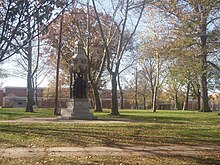

Downtown / E-Port (a.k.a. The Port and Elizabethport) is the oldest neighborhood in Elizabeth. It consists of a collection of old world Elizabethan, new American colonial-style houses and apartment buildings that stretch east of 7th Street to its shores. The name is derived from its dependence on businesses catering to seagoing ventures. It was a thriving center of commerce between the 1660s through the middle of the 20th century. This area has had a great deal of improvement since 2000. Many homes have been renovated or been replaced with new, more ornate structures. Federal housing projects that stood for decades along First Street have been demolished and replaced with low to moderate income housing. The waterfront is home to new town homes and two-family homes (duplexes).
The area was once three distinct neighborhoods: Buckeye, Diamondville, and New Mexico. It was the US home of the Singer Manufacturing Company, makers of Singer sewing machines, which constructed a 1,400,000-square-foot (130,000 m2) facility on a 32-acre (13 ha) site in 1873. Shortly after it opened, the factory manufactured the majority of all sewing machines worldwide. With 6,000 employees working there in the 1870s, it employed the largest number of workers at a single facility in 1873. The company moved out of Elizabeth in 1982.[47]
Elizabeth Marina, which was once filled with trash and debris along its walkway, was also restored. It is the site of year-round celebrations from a Hispanic festival in late spring to the lighting of a Christmas tree in winter. Living conditions in this area continue to improve year after year. Historically, there were immigrant communities centered around Christian churches. The Slavic community was centered by Sts. Peter and Paul Byzantine, the Lithuanian community attended Sts. Peter and Paul Roman Catholic and the Polish community attended St. Adalbert Roman Catholic Church which still stands. St. Patrick Church, originally Irish, dominates the 'Port; the cornerstone for the second and current building was laid in 1887.[48]
Elmora and The West End

Elmora is a middle/working-class neighborhood in the western part of Elizabeth. The main thoroughfare, Elmora Avenue, offers restaurants, shops and boutiques. Several high-rise building complexes, affording views of the New York City skyline, dot the edge of this neighborhood and are accessible to the Elizabeth station. The neighborhood area forms a "V" from its approximate borders of the Central Railroad tracks to Rahway Avenue.
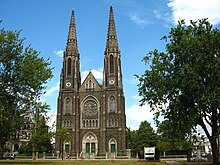
Elmora's modern Orthodox community
The Elmora section of Elizabeth is home to a large Modern Orthodox community. The Jewish Educational Center of Elizabeth was founded in 1941 by a Latvian-born rabbi, Pinchas Mordechai Teitz, who arrived to lecture in to the city's then-small Orthodox community in the 1930s.[49][50]
Elmora Hills
The northwestern part of Elmora is known as Elmora Hills. It is a strongly middle- to upper-middle-class neighborhood. Originally called Shearerville, the name Elmora came from the developers of the area, the El Mora Land Company. This area was annexed from Union Township, returning to Elizabeth in the early part of the 20th century. This was done to increase the city's tax base as major improvements to infrastructure were necessary at the time.
Frog Hollow
Frog Hollow is a small community of homes east of Atlantic Street, west of the Arthur Kill, and south of Elizabeth Avenue. Its name is derived from the frogs that could be caught in its marshes as well as the oyster and fishing of the past. The area expanded east and includes the area formerly known as Helltown. Helltown included many of the docks and shipyards, as well as several drydocks. The area's developer was Edward N. Kellogg, who also laid out the neighborhood in Keighry Head. Frog Hollow contains older-style, more affordable homes, rentals, and some quality restaurants in a working-class community. The statue honoring former Mayor Mack on Elizabeth Avenue is a landmark in the community. Frog Hollow is also convenient to the Veteran's Memorial Waterfront Park.
Keighry Head
Its name is attributed to James Keighry of the Isle of Kerry, Ireland. He owned a business facing the square formed at the junction of Jackson, Madison, Chestnut and Magnolia Avenues. The approximate borders of this neighborhood extended north from East Grand Street to Flora Street and from Walnut to Division Street. Developed by Edward N. Kellogg, many of the streets were named after family and friends. Keighry Head is located close to Midtown, containing affordable one and two-family homes, and apartment houses, convenient to the Midtown shopping district, and transportation.
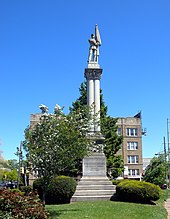
North End / North Elizabeth
The North End, also known as "North Elizabeth", is a diverse working-class neighborhood. The borders are approximately the Arch north to the city line between North Broad Street and US 1&9. It was developed mostly in the 1920s for workers in the Duesenberg automobile plant (later Durant Auto, Burry Biscuits and Interbake Foods). The area was heavily settled by the Irish and then Portuguese. The North End has easy access to New York City and Newark via its own NJ Transit train station, Routes 1 and 9 and the New Jersey Turnpike. The neighborhood also has Crane Square, the Historic Nugents Tavern, and Kellogg Park, and is within close proximity to Newark Liberty International Airport. There is a current plan to develop the former Interbake Foods facility into shopping and residential townhouses and condominiums. This community contains many larger one and two-family homes that have been rebuilt over the past decade. North Elizabeth also features many well-kept apartment houses and condominium units on and around North Avenue that are home to professionals who work in New York or the area. The only Benedictine women's community in New Jersey is located at Saint Walburga Monastery on North Broad Street.
Peterstown
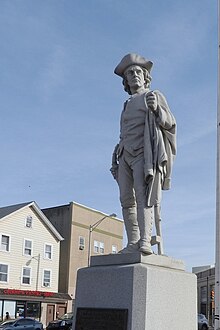
Peterstown (also known as "The Burg") is a middle/working-class neighborhood in the southeastern part of the city. Its borders run west of Atlantic Street to South Spring Street from 1st Avenue to the Elizabeth River. Its name is derived from John Peters, who owned most of the land with George Peters. They divided the land and developed it during the end of the 19th century. The area was once predominantly occupied by its earliest settlers, who were German, and during the 1920s was gentrified by newly immigrated Italians. Peterstown has clean, quiet streets and has many affordable housing opportunities with a "village" feel. The area contains the historic Union Square, which is home to produce stands, meat markets, fresh fish and poultry stores. Peterstown is also home of the DeCavalcante crime family, one of the most infamous Mafia families in the United States.
The Point / the Crossroads
The Point, formally known as the Crossroads, is centrally located and defined by New Point Road and Division Street. It is close to Midtown and contains many new affordable two-family homes, apartment houses and is undergoing a transformation. The former Elizabeth General Hospital site is currently being demolished and awaiting a new development.
Quality Hill
Home to St. Mary's and the "Hilltoppers", this area once was lined with mansions. Its approximate borders were South Broad Street to Grier Avenue and Pearl Street to what is now US 1&9. During its development in the 1860s it was the most fashionable area of the city to live. It is now a quiet middle class community experiencing a re-development with many new condominiums.
Westminster
Developed by Edward J. Grassman, Westminster got its name from the city's largest residential estates of the Tudor style and was inhabited by many residents who traced their ancestry to England. This neighborhood borders Hillside with the Elizabeth River running its border creating a dramatic splash of greenery and rolling hills off of North Avenue, near Liberty Hall. Residents use this area for recreation, whether it is at the newly christened Phil Rizzuto Park area, or for bird watching or for sunbathing by the river. It is one of the more affluent areas of Elizabeth.
Climate
The climate in this area is characterized by hot, humid summers and cool to cold winters. According to the Köppen Climate Classification system, Elizabeth straddles the boundary between a humid subtropical climate and a hot-summer humid continental climate.[51]
Demographics
| Census | Pop. | Note | %± |
|---|---|---|---|
| 1810 | 2,977 | — | |
| 1820 | 3,515 | 18.1% | |
| 1830 | 3,455 | −1.7% | |
| 1840 | 4,184 | 21.1% | |
| 1850 | 5,583 | 33.4% | |
| 1860 | 11,567 | 107.2% | |
| 1870 | 20,832 | * | 80.1% |
| 1880 | 28,229 | 35.5% | |
| 1890 | 37,764 | 33.8% | |
| 1900 | 52,130 | 38.0% | |
| 1910 | 73,409 | 40.8% | |
| 1920 | 95,783 | 30.5% | |
| 1930 | 114,589 | 19.6% | |
| 1940 | 109,912 | −4.1% | |
| 1950 | 112,817 | 2.6% | |
| 1960 | 107,698 | −4.5% | |
| 1970 | 112,654 | 4.6% | |
| 1980 | 106,201 | −5.7% | |
| 1990 | 110,002 | 3.6% | |
| 2000 | 120,568 | 9.6% | |
| 2010 | 124,969 | 3.7% | |
| 2020 | 137,298 | 9.9% | |
| 2023 (est.) | 135,829 | [11][14][13] | −1.1% |
| Population sources: 1810–1970[52] 1810–1920[53] 1810[54] 1820[55] 1830[56] 1840[57] 1850–1870[58] 1850[59] 1870[60] 1880–1890[61] 1890–1910[62] 1860–1930[63] 1940–2000[64] 2000[65][66] 2010[25][26][67] 2020[11][12] * = Lost territory in previous decade.[35] | |||
This section needs to be updated. The reason given is: Newer information is available from the 2020 Census report. (November 2021) |
2020 census
| Race / Ethnicity (NH = Non-Hispanic) | Pop 2000[68] | Pop 2010[69] | Pop 2020[70] | % 2000 | % 2010 | % 2020 |
|---|---|---|---|---|---|---|
| White alone (NH) | 32,338 | 22,705 | 16,553 | 26.82% | 18.17% | 12.06% |
| Black or African American alone (NH) | 22,329 | 23,072 | 22,261 | 18.52% | 18.46% | 16.21% |
| Native American or Alaska Native alone (NH) | 145 | 138 | 152 | 0.12% | 0.11% | 0.11% |
| Asian alone (NH) | 2,745 | 2,521 | 2,757 | 2.28% | 2.02% | 2.01% |
| Pacific Islander alone (NH) | 18 | 31 | 18 | 0.01% | 0.02% | 0.01% |
| Other race alone (NH) | 496 | 811 | 2,145 | 0.41% | 0.65% | 1.56% |
| Mixed race or Multiracial (NH) | 2,870 | 1,338 | 3,179 | 2.38% | 1.07% | 2.32% |
| Hispanic or Latino (any race) | 59,627 | 74,353 | 90,233 | 49.46% | 59.50% | 65.72% |
| Total | 120,568 | 124,969 | 137,298 | 100.00% | 100.00% | 100.00% |
In 2019, the foreign-born population in the city was 46.6% of the total population, and the Latino population was 65%.[71]
2010 census
The 2010 United States census counted 124,969 people, 41,596 households, and 29,325 families in the city. The population density was 10,144.1 per square mile (3,916.7/km2). There were 45,516 housing units at an average density of 3,694.7 per square mile (1,426.5/km2). The racial makeup was 54.65% (68,292) White, 21.08% (26,343) Black or African American, 0.83% (1,036) Native American, 2.08% (2,604) Asian, 0.04% (52) Pacific Islander, 16.72% (20,901) from other races, and 4.59% (5,741) from two or more races. Hispanic or Latino residents of any race were 59.50% (74,353) of the population.[25] Elizabeth had the tenth-highest percentage of Hispanic residents among municipalities in New Jersey in 2010.[72]
Of the 41,596 households, 37.0% had children under the age of 18; 39.2% were married couples living together; 22.0% had a female householder with no husband present and 29.5% were non-families. Of all households, 23.5% were made up of individuals and 7.2% had someone living alone who was 65 years of age or older. The average household size was 2.94 and the average family size was 3.43.[25]
25.6% of the population were under the age of 18, 10.6% from 18 to 24, 31.3% from 25 to 44, 23.3% from 45 to 64, and 9.2% who were 65 years of age or older. The median age was 33.2 years. For every 100 females, the population had 98.6 males. For every 100 females ages 18 and older there were 96.8 males.[25]
The Census Bureau's 2006–2010 American Community Survey showed that (in 2010 inflation-adjusted dollars) median household income was $43,770 (with a margin of error of +/− $1,488) and the median family income was $46,891 (+/− $1,873). Males had a median income of $32,268 (+/− $1,205) versus $27,228 (+/− $1,427) for females. The per capita income for the borough was $19,196 (+/− $604). About 14.7% of families and 16.7% of the population were below the poverty line, including 23.5% of those under age 18 and 18.5% of those age 65 or over.[73]
2000 census
As of the 2000 United States census[19] there were 120,568 people, 40,482 households, and 28,175 families residing in the city. The population density was 9,865.5 inhabitants per square mile (3,809.1/km2). There were 42,838 housing units at an average density of 3,505.2 per square mile (1,353.4/km2). The racial makeup of the city was 55.78% White, 19.98% Black or African American, 0.48% Native American, 2.35% Asian, 0.05% Pacific Islander, 15.51% from other races, and 5.86% from two or more races. Hispanic or Latino of any race were 49.46% of the population.[65][66]
Colombia is the nation of birth for the highest number of foreign-born inhabitants of Elizabeth; it was the birthplace of 8,731 Elizabeth residents as of the 2000 Census. This exceeded the combined total of 8,214 for Mexican and Central American immigrants. It also far exceeded the next highest single nation count of Cuba at 5,812. The highest number for a non-Spanish speaking country and third highest overall was Portugal, whose native-born immigrants numbered 4,544. The next largest groups were Salvadoran immigrants numbering 4,043, Peruvians at 3,591 and Dominican immigrants, of whom there were 3,492.[74]
There were 40,482 households, out of which 36.6% had children under the age of 18 living with them, 42.9% were married couples living together, 19.1% had a female householder with no husband present, and 30.4% were non-families. 24.6% of all households were made up of individuals, and 8.4% had someone living alone who was 65 years of age or older. The average household size was 2.91 and the average family size was 3.45.[65][66]
In the city the population was spread out, with 26.3% under the age of 18, 10.8% from 18 to 24, 33.7% from 25 to 44, 19.3% from 45 to 64, and 10.0% who were 65 years of age or older. The median age was 33 years. For every 100 females, there were 98.0 males. For every 100 females age 18 and over, there were 96.1 males.[65][66]
The median income for a household in the city was $35,175, and the median income for a family was $38,370. Males had a median income of $30,757 versus $23,931 for females. The per capita income for the city was $15,114. About 15.6% of families and 17.8% of the population were below the poverty line, including 22.2% of those under age 18 and 17.2% of those age 65 or over.[65][66]
Economy
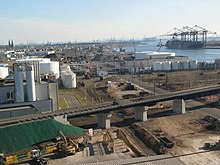
Since World War II, Elizabeth has seen its transportation facilities grow; the Port Newark-Elizabeth Marine Terminal is one of the busiest ports in the world, as is Newark Liberty International Airport, located in both Newark and Elizabeth. Elizabeth also features Little Jimmy's Italian Ices (since 1932), The Mills At Jersey Gardens outlet mall, Loews Theater, and the Elizabeth Center, which generate millions of dollars in revenue. Companies based in Elizabeth included New England Motor Freight.
Together with Linden, Elizabeth is home to the Bayway Refinery, a Phillips 66 refining facility that supplies petroleum-based products to the New York/New Jersey area, producing approximately 230,000 barrels (37,000 m3) per day.[75]
Celadon, a mixed-use development containing 14 glass skyscrapers, offices, retail, a hotel, boardwalk and many other amenities is proposed to border the east side of The Mills at Jersey Gardens, directly on the Port Newark Bay. Groundbreaking was scheduled for the summer of 2008 on the ferry, roads and parking, and construction was planned to continue for at least twelve years. As of 2021 this project has not started construction and there is no recent news about Celadon, so it is assumed that this project has been canceled[76]
Portions of the city are part of an Urban Enterprise Zone (UEZ), one of 32 zones covering 37 municipalities statewide. Elizabeth was selected in 1983 as one of the initial group of 10 zones chosen to participate in the program.[77] In addition to other benefits to encourage employment and investment within the Zone, shoppers can take advantage of a reduced 3.3125% sales tax rate (half of the 6+5⁄8% rate charged statewide) at eligible merchants.[78] Established in November 1992, the city's Urban Enterprise Zone status expires in November 2023.[79]
Government
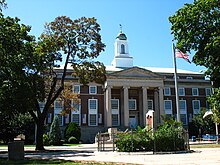
Local governmentedit
The City of Elizabeth is governed within the Faulkner Act, formally known as the Optional Municipal Charter Law, under the Mayor-Council system of municipal government. The city is one of 71 municipalities (of the 564) statewide that use this form of government.[81] The governing body is comprised of the Mayor and the City Council. The Elizabeth City Council includes nine members, who are elected to serve four-year terms of office on a staggered basis with elections held in even-numbered years. The mayor and the three council members elected at-large come up for election together in leap years and two years later the six members who are elected from each of Elizabeth's six wards are all up for election.[8][82]
As of 2024[update], the city's Mayor is Democrat Chris Bollwage, a lifelong resident of Elizabeth who is serving his eighth term as Mayor, serving a term of office that ends December 31, 2024.[4] City Council members are Council President Carlos L. Torres (First Ward; D, 2026), Carlos Cedeño (Fourth Ward; D, 2026), Frank J. Cuesta (at-large; D, 2024), William Gallman Jr. (Fifth Ward; D, 2026), Nelson Gonzalez (Second Ward; D, 2026), Manny Grova Jr. (at-large; D, 2024), Kevin Kiniery (Third Ward; D, 2026), Frank O. Mazza (Sixth Ward; D, 2026), and Patricia Perkins-Auguste (at-large; D, 2024).[83][84][85][86][87]
Bollwage, who has served as mayor of Elizabeth since 1992, was paid an annual salary of $152,564 in 2016, placing him among the three highest-paid mayors in the state and the only mayor in Union County to earn annual compensation in excess of $100,000.[88][89]
Federal, state and county representationedit
Elizabeth is located in the 8th Congressional District[90] and is part of New Jersey's 20th state legislative district.[91][92][93] Prior to the 2010 Census, Elizabeth had been split between the 10th Congressional District and the 13th Congressional District, a change made by the New Jersey Redistricting Commission that took effect in January 2013, based on the results of the November 2012 general elections.[94]
For the 118th United States Congress, New Jersey's 8th congressional district is represented by Rob Menendez (D, Jersey City).[95][96] New Jersey is represented in the United States Senate by Democrats Cory Booker (Newark, term ends 2027)[97] and Bob Menendez (Englewood Cliffs, term ends 2025).[98][99]
For the 2024-2025 session, the 20th legislative district of the New Jersey Legislature is represented in the State Senate by Joseph Cryan (D, Union Township) and in the General Assembly by Reginald Atkins (D, Roselle) and Annette Quijano (D, Elizabeth).[100]
Union County is governed by a Board of County Commissioners, whose nine members are elected at-large to three-year terms of office on a staggered basis with three seats coming up for election each year, with an appointed County Manager overseeing the day-to-day operations of the county. At an annual reorganization meeting held in the beginning of January, the board selects a Chair and Vice Chair from among its members.[101] As of 2024[update], Union County's County Commissioners are:
Rebecca Williams (D, Plainfield, 2025),[102] Joesph Bodek (D, Linden, 2026),[103] James E. Baker Jr. (D, Rahway, 2024),[104] Michele Delisfort (D, Union Township, 2026),[105] Sergio Granados (D, Elizabeth, 2025),[106] Bette Jane Kowalski (D, Cranford, 2025),[107] Vice Chair Lourdes M. Leon (D, Elizabeth, 2026),[108] Alexander Mirabella (D, Fanwood, 2024)[109] and Chair Kimberly Palmieri-Mouded (D, Westfield, 2024).[110][111]
Constitutional officers elected on a countywide basis are: Clerk Joanne Rajoppi (D, Union Township, 2025),[112][113] Sheriff Peter Corvelli (D, Kenilworth, 2026)[114][115] and Surrogate Christopher E. Hudak (D, Clark, 2027).[116][117]
Politicsedit
As of March 23, 2011, there were a total of 44,415 registered voters in Elizabeth, of which 24,988 (56.3% vs. 41.8% countywide) were registered as Democrats, 2,430 (5.5% vs. 15.3%) were registered as Republicans and 16,985 (38.2% vs. 42.9%) were registered as Unaffiliated. There were 12 voters registered to other parties.[118] Among the city's 2010 Census population, 35.5% (vs. 53.3% in Union County) were registered to vote, including 47.8% of those ages 18 and over (vs. 70.6% countywide).[118][119]
In the 2012 presidential election, Democrat Barack Obama received 24,751 votes (80.8% vs. 66.0% countywide), ahead of Republican Mitt Romney with 5,213 votes (17.0% vs. 32.3%) and other candidates with 166 votes (0.5% vs. 0.8%), among the 30,640 ballots cast by the city's 50,715 registered voters, for a turnout of 60.4% (vs. 68.8% in Union County).[120][121] In the 2008 presidential election, Democrat Barack Obama received 23,524 votes (74.3% vs. 63.1% countywide), ahead of Republican John McCain with 7,559 votes (23.9% vs. 35.2%) and other candidates with 202 votes (0.6% vs. 0.9%), among the 31,677 ballots cast by the city's 48,294 registered voters, for a turnout of 65.6% (vs. 74.7% in Union County).[122] In the 2004 presidential election, Democrat John Kerry received 18,363 votes (67.2% vs. 58.3% countywide), ahead of Republican George W. Bush with 8,486 votes (31.0% vs. 40.3%) and other candidates with 144 votes (0.5% vs. 0.7%), among the 27,334 ballots cast by the city's 45,882 registered voters, for a turnout of 59.6% (vs. 72.3% in the whole county).[123]
In the 2013 gubernatorial election, Democrat Barbara Buono received 63.2% of the vote (7,804 cast), ahead of Republican Chris Christie with 35.5% (4,379 votes), and other candidates with 1.3% (163 votes), among the 13,592 ballots cast by the city's 49,515 registered voters (1,246 ballots were spoiled), for a turnout of 27.5%.[124][125] In the 2009 gubernatorial election, Democrat Jon Corzine received 10,258 ballots cast (66.8% vs. 50.6% countywide), ahead of Republican Chris Christie with 4,386 votes (28.6% vs. 41.7%), Independent Chris Daggett with 376 votes (2.4% vs. 5.9%) and other candidates with 131 votes (0.9% vs. 0.8%), among the 15,355 ballots cast by the city's 46,219 registered voters, yielding a 33.2% turnout (vs. 46.5% in the county).[126]
Police departmentedit
The Elizabeth Police Department was established in May 1858.
The current Police Director is Earl Graves and the Chief of Police is Giacomo Sacca.[127]
The Table of Organization authorizes 365 officers,[128] including 9 captains, 21 lieutenants and 39 sergeants.[129]
Fire departmentedit
| Operational area | |
|---|---|
| Country | United States |
| State | New Jersey |
| City | Elizabeth |
| Agency overview | |
| Established | January 1, 1902 |
| Staffing | Career |
| Fire chief | Sal Barraco[130] |
| EMS level | BLS |
| Facilities and equipment | |
| Divisions | 1 |
| Battalions | 2 |
| Stations | 7 |
| Engines | 7 |
| Trucks | 3 |
| Rescues | 1 |
| Ambulances | 5 |
| Tenders | 1 |
| HAZMAT | 1 |
| USAR | 1 |
| Fireboats | 1 |
| Light and air | 1 |
The Elizabeth Fire Department provides fire protection and emergency medical services to the city of Elizabeth.[131] The Elizabeth Fire Department was established as a volunteer organization in 1837 when Engine Company # 1 was organized. In 1901, the volunteer department was no longer adequate and the department reorganized into a paid department on January 1, 1902.[132] There are 7 Engine Companies, 3 Ladder Companies, 1 Rescue Company, and several Special Units. These companies and units are under the command of both a Deputy Chief and two Battalion Chiefs.
The department is part of the Metro USAR Strike Team, which consists of nine North Jersey fire departments and other emergency services divisions working to address major emergency rescue situations.[133]




